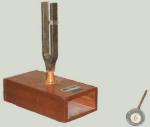Description
It is the classical sonometer with the one-metre strings.
The mahogany resonance-box, with its upper board and bottom made of fie-wood,
is 1,30 m long and rest on metallic feet with a levelling screw.
The tension of one of the strings can be obtained by passing the string on the
throat of the brass pulley and by applying the lead weights attached to the instrument on
the plate.
Three white celluloid scales are fixed on the harmonic table: the first is divided
into mm, the second with divisions corresponding to the length to give the string to
obtain the just scale and the third one with divisions for the equally tempered scale.
The three bridges are applied on the protruding scales that are used as their guides. To
determine the number of vibrations corresponding to the sound we bring the string to the
unison with a known tuning fork. We make the bridge slide until the string reproduces the
sound we are examining and we apply the law: the number of vibrations of a string at constant
tension is inversely proportional to the length.
|


 Menu
Menu







